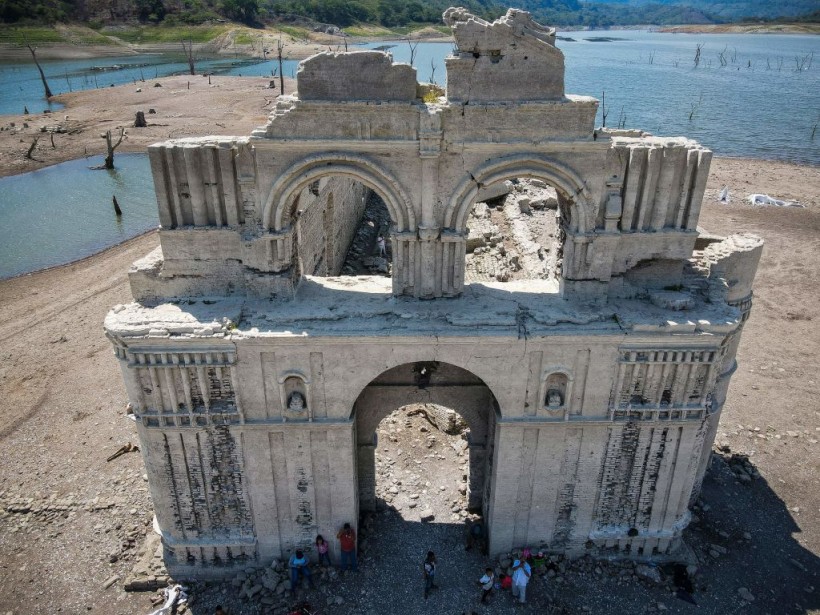The Temple of Santiago, an impressive Catholic church from the 16th century, has emerged from the Nezahualcoyotl Reservoir in Mexico as water levels drastically dropped due to a severe drought. While the structure has been partially visible during low water periods, MailOnline reported that this year's drought has completely exposed it, posing a threat to the local fishermen's way of life.
Built by monks led by Friar Bartolome de la Casas, the church was originally submerged in 1966 when the reservoir flooded. Its reemergence offers a fascinating glimpse into the region's rich historical past.

Aerial view of the Temple of Quechula church emerging from the Malpaso Dam after water levels dropped due to the drought in Nuevo Quechula, Chiapas, on June 16, 2023.
Extreme Drought Reveals Submerged Ancient Building
The dam construction in 1966 left the Catholic church mostly submerged. Previously accessible only by boat, the church now stands fully exposed, attracting visitors who can reach it by car and motorcycle.
As per Newsweek, the prolonged drought, coupled with high temperatures, has led to a drop in water levels in the Mexican reservoir, fully uncovering the 16th-century Dominican church in Quechula. Tourists who previously reached the church by boat can now drive or ride motorcycles to visit.
However, the decreased water levels pose challenges for local fishermen, particularly those involved in tilapia farming. The diminishing water supply has severely impacted their ability to sustain their families and livelihoods, raising concerns about the long-term implications.
The church, constructed by the Dominican Order during the Spanish colonial period, represents the historical presence of the order in Mexico. Founded in 1215 by Spanish priest Saint Dominic, the Dominican Order, consisting of over 5,000 members today, was established to spread the gospel and combat heresy.
Dominican friars were among the first European missionaries in the Americas, arriving during the 16th century to establish churches across various countries. Their journey began in Santo Domingo, currently the Dominican Republic, and expanded to Mexico by 1526.
In a separate archaeological discovery, researchers recently unveiled the remains of a submerged church off the coast of Germany. The church is believed to be associated with the medieval trading settlement of Rungholt, often dubbed the "Atlantis of the North Sea." Submerged in a devastating storm surge around 700 years ago, the church's discovery provides valuable insights into the history and existence of this lost settlement.
READ ALSO: 2,500-Year-Old Ancient Greek City Reemerged After Months of Extreme Drought in Turkiye
Drought in Mexico
Drought conditions are prevalent in Mexico, with below-average rainfall occurring for several months and years, as per the Mexico Daily Post. Only three states, namely Campeche, Tabasco, and Yucatán, have normal precipitation levels and are not considered to be experiencing drought.
As of March 1, the remaining 28 states are below average in terms of rainfall. The situation is particularly concerning in Colima, Aguascalientes, Jalisco, Nayarit, Zacatecas, Durango, Baja California Sur, Michoacán, and Sinaloa.
These areas are facing moderate to severe drought, resulting in damage to crops and pastures, an increased risk of forest fires, and low levels of water in rivers, streams, reservoirs, dams, and other bodies of water. Out of the 32 states in Mexico, 16 have been significantly impacted by drought, although the severity varies across different municipalities.
The affected areas range from abnormally dry to moderately dry, posing challenges to agricultural activities, water availability, and environmental stability. The situation calls for increased attention and proactive measures to mitigate the effects of the ongoing drought conditions.
RELATED ARTICLE: Severe Drought Reveals 113-Million-Year-Old Dinosaur Footprints at A Dried Up River in Texas
Check out more news and information on Drought in Science Times.














